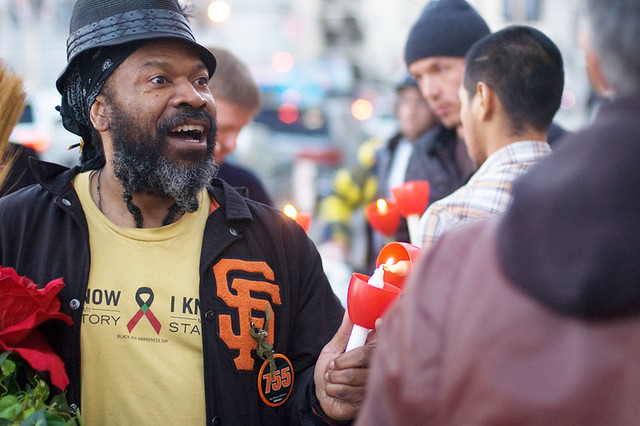
Local activists gathered on the steps of City Hall Monday for a candlelight vigil and march in an effort to raise awareness of the large numbers of black Americans infected with HIV.
According to Centers for Disease Control and Prevention, among those who are infected with the virus, 49 percent are African-American, even though the black community only makes up 12 percent of the United States population.
As the disparity continues to grow, local San Francisco activists have used National Black HIV/AIDS Awareness Day to educate community members about the problem and hopefully limit transmission of the deadly virus.
San Francisco’s Department of Public Health organized a press conference at the beginning of the event.
The press conference was followed with a candlelight vigil and march to the African-American Arts and Cultural Center, where more presenters spoke about the importance of inclusion. This year’s theme was “It Takes a Village to Fight HIV/AIDS!”
“San Francisco, our village, comes in all hues and colors,” said speaker James Loyce, the executive director of Building a Healthy Black Community. “It is important to make sure that we’re inclusive.”
The conference revolved around the need to be educated about the infection, tested, and then treated, in the case of people found HIV-positive.
“All of them are important but education is a huge component of it,” said Vincent Fuqua, a health educator at the HIV-prevention section of SFDPH. “For people who are HIV-negative, the main goal is to keep them negative.”
Fuqua also said that community involvement plays a role in prevention and detection of the virus. “If you don’t feel connected to your community, there’s a better chance that you put yourself at risk because you’re just not at the point where you care about yourself yet and you don’t feel like you have the support,” he said.
According to Fuqua, many African-Americans keep to themselves and don’t feel they belong to the community, so the virus tends to spread within the enclave quickly if an individual becomes infected.
He also commented on the importance of erasing the stigma in the community. For that, he will need not only the help of those who are HIV-positive but also every single person who walks the streets of San Francisco.
“Today, less people are in denial about it. [There is] a lot more awareness regarding it,” Fuqua said. “I think we’re heading to the right direction of reducing the disparity.”
This year marks the 11th year of the NBHAAD and 30 years since the first case of HIV/AIDS was reported in the United States. Progress has been made in the treatment of HIV/AIDS, but the virus continues to spread. According to the CDC, by 2006, approximately 200,000 African-Americans had already died because of the virus.
Some people, such as Rev. Dr. William H. Knight, who also spoke at the cultural center, are still hopeful about the future of eliminating the virus.
“The virus is a situation,” Knight said. “You are the solution.”




